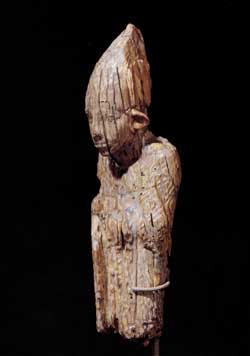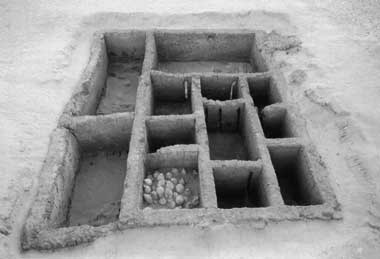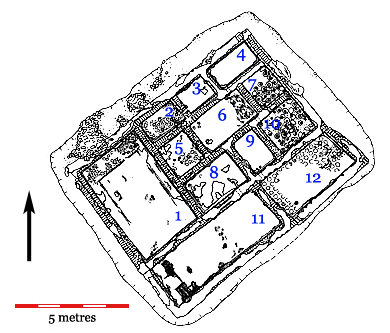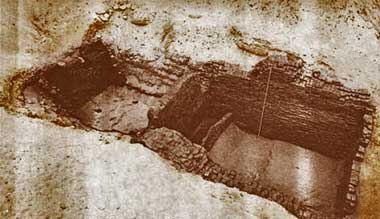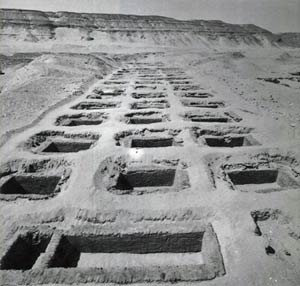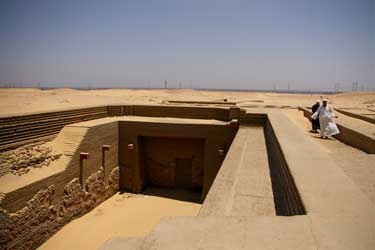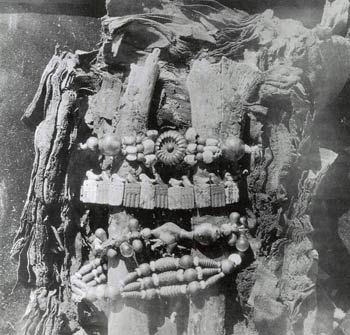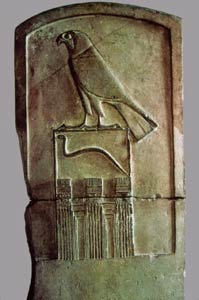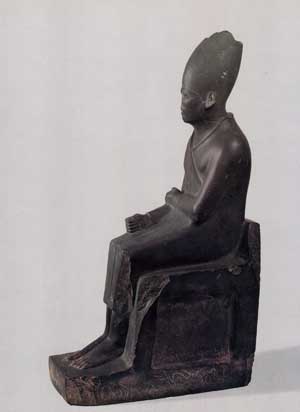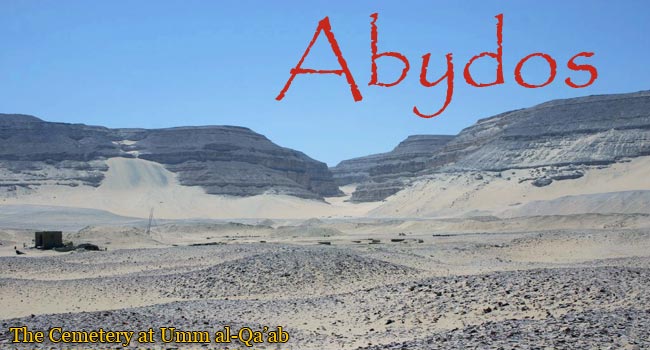
Abydos
Abydos lays quite close to the dynastic capital of the First Dynasty pharaohs at Thinis, which was located somewhere in the immediate vicinity of Abydos. The latter was associated in later times with the god Osiris, lord of the afterlife. However, there are 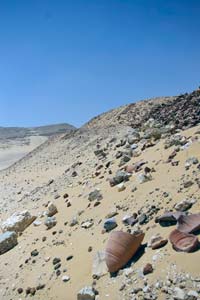 no contemporary references to the god until late in the Old Kingdom and his association with the site was probably on account of the presence of the early tombs rather than the reverse. The tomb of Djer was widely believed by later Egyptians to be that of the dead god.
no contemporary references to the god until late in the Old Kingdom and his association with the site was probably on account of the presence of the early tombs rather than the reverse. The tomb of Djer was widely believed by later Egyptians to be that of the dead god.
The Early Dynastic cemetery is located about half a kilometre into the desert on the west bank of the Nile, backed by a line of cliffs that form a broad embayment cut by deep ravine. The tombs themselves were on a low rise overlooking the wadi that ran from the cliffs to the cultivation. The site is known as Umm al-Qa’ab (“mother of pots”) from the huge deposits of broken food vessels left as offerings by ancient visitors to the site (left). The tombs were first investigated by Émile Amélineau in the 1890’s and, more systematically, by Flinders Petrie from 1899-1901. Since the 1970’s the site has been re-investigated by the German Archaeological Institute, most recently under the direction of Günter Dreyer.
The earlier excavations uncovered the subterranean chambers of a number of tombs associated with all of the pharaohs of Dynasty I and the final two of Dynasty II. The tombs had been thoroughly ransacked in antiquity but the robber’s were not interested in items with little market 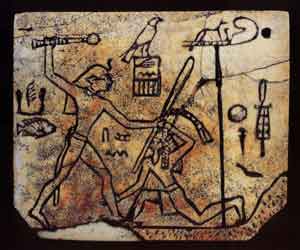 value. Only a few broken fragments were found out of what must have been a substantial amount of grave goods. Pottery vessels containing food and drink were not of much use to them but are of enormous importance to scholars because they include the name of the owner of the estate that produced them. Similarly, the boxes of jewellery, the furnishings and the items of clothing placed in the tomb were labelled with tags made out of ivory or wood. They give the type of artefact to which it was attached along with the name of its owner and there was often a summary of the year’s significant events. The label of Den (right) was attached to a pair of sandals (drawn on the reverse) and shows pharaoh smiting an Asiatic chieftain with the serekh bearing his name between them. These sealings and labels are the only means by which the ownership of the tombs can be determined—no intact burials have been found and the only human remains belong to servants found in subsidiary graves associated with the tombs and part of a detached arm found in the Tomb of Djer.
value. Only a few broken fragments were found out of what must have been a substantial amount of grave goods. Pottery vessels containing food and drink were not of much use to them but are of enormous importance to scholars because they include the name of the owner of the estate that produced them. Similarly, the boxes of jewellery, the furnishings and the items of clothing placed in the tomb were labelled with tags made out of ivory or wood. They give the type of artefact to which it was attached along with the name of its owner and there was often a summary of the year’s significant events. The label of Den (right) was attached to a pair of sandals (drawn on the reverse) and shows pharaoh smiting an Asiatic chieftain with the serekh bearing his name between them. These sealings and labels are the only means by which the ownership of the tombs can be determined—no intact burials have been found and the only human remains belong to servants found in subsidiary graves associated with the tombs and part of a detached arm found in the Tomb of Djer.
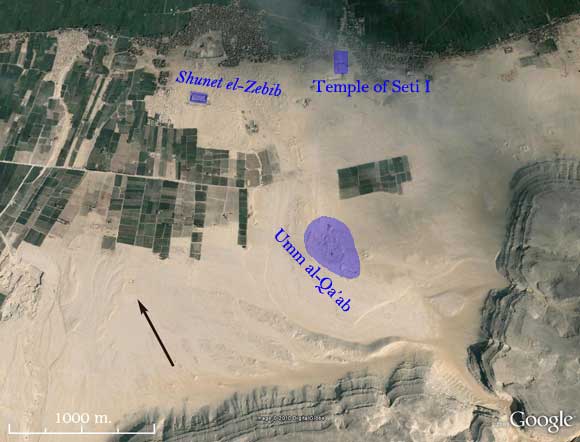
GoogleEarth© Image of Abydos
Also at Abydos, about 1.5 km due north of the cemetery and at the edge of the cultivation, is a group of large, rectangular mud-brick enclosures that are apparently associated with the royal tombs. The largest of these, Shunet ez-Zebib, belongs to the last king of the Early Dynastic Period, Khasekhemwy.
Dreyer’s investigations have shown that the site was used as a cemetery for several centuries before the Early Dynastic Period. 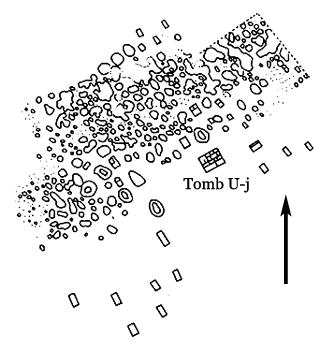 The Predynastic tombs are found in an area to the north of Umm al-Qa’ab in an area designated Cemetery U. Among them, they cover the entire Naqada Period (c. 4400-3000 BC), with the earliest graves found to the northwest and the later ones extending southwards. Between Cemetery U and Umm al-Qa’ab is a small collection of well-built tombs, cleared by in an area designated by Petrie as Cemetery B, which would seem to belong to the immediate predecessors of the legendary Menes.
The Predynastic tombs are found in an area to the north of Umm al-Qa’ab in an area designated Cemetery U. Among them, they cover the entire Naqada Period (c. 4400-3000 BC), with the earliest graves found to the northwest and the later ones extending southwards. Between Cemetery U and Umm al-Qa’ab is a small collection of well-built tombs, cleared by in an area designated by Petrie as Cemetery B, which would seem to belong to the immediate predecessors of the legendary Menes.
Cemetery U (left) was in use throughout most of the Naqada Period and the increased distinction in status can be seen clearly. There are a number of rectangular brick lined tombs that come late in the sequence. Most of them lie slightly away from the rest of the site and to the southeast, between it and Umm al-Qa’ab. All of them were rich in grave goods and a few were provided with a separate chamber to hold the surplus. One of the tombs in Cemetery U, designated U-j, was much more elaborate than the rest and had 12 rooms altogether. It measured 9.1 x 7.3 metres and had been built in two stages, with the two 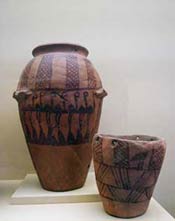 long rooms on the southeast side added later on. Although most of the rooms had been plundered in antiquity, the tomb must have been exceptionally rich—eleven storerooms would have represented a huge increase in capacity. However, several hundred pottery vessels, both locally made and Palestinian imports, were discovered largely undisturbed. They had been sorted according to type—jars with wavy ledged handles (right) were particularly common. Many of them bore inscriptions, which are very brief but do include several examples of the serekh panel suggesting that they belong to royal personages. Prominent are ones that includes ideograms depicting a scorpion and a tree. Others, according to Dreyer, belong to the successor of the tomb owner along with seven of his predecessors, whose estates provided offerings for the tomb and whose own tombs should be found nearby.
long rooms on the southeast side added later on. Although most of the rooms had been plundered in antiquity, the tomb must have been exceptionally rich—eleven storerooms would have represented a huge increase in capacity. However, several hundred pottery vessels, both locally made and Palestinian imports, were discovered largely undisturbed. They had been sorted according to type—jars with wavy ledged handles (right) were particularly common. Many of them bore inscriptions, which are very brief but do include several examples of the serekh panel suggesting that they belong to royal personages. Prominent are ones that includes ideograms depicting a scorpion and a tree. Others, according to Dreyer, belong to the successor of the tomb owner along with seven of his predecessors, whose estates provided offerings for the tomb and whose own tombs should be found nearby.
Tomb U-j represents a dramatic leap in scale and complexity over previous tombs and must have belonged to an extraordinary individual. The excavators found traces of a wooden shrine in the burial chamber (Room 1) along with an ivory heqa-sceptre (essentially a shepherd’s crook), which was a powerful symbol of kingship in the historic period. It would appear, then, that the tomb belonged to a pharaoh, perhaps with the name ‘Scorpion.’ Dreyer has identified other ‘royal’ tombs in the cemetery— mainly on the basis of size and the number of rooms— but, in most cases, there is little to distinguish ‘royal’ tombs from those of other high-ranking individuals. Egyptian tradition suggests that there were a number of pharaohs ruling a united land before Menes and the original occupant of this tomb was almost certainly one of them.
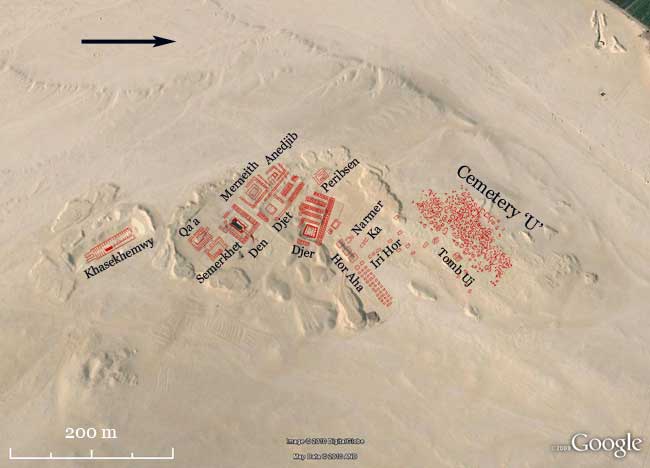
Google Earth image of Umm al-Qa’ab
Cemetery B lies immediately to the north of the main cemetery at Umm al-Qa’ab and contains four major tombs. Three of them, each consisting of two burial chambers, have been identified, on the basis of seal impressions and fragments of inscribed pottery, with Narmer and two of his predecessors, Ka and Iri Hor. The fourth is 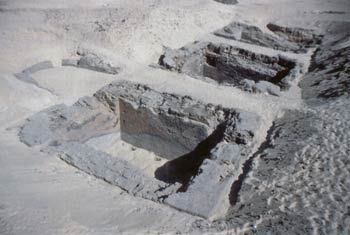 that of Aha, the current front runner for the part of Menes. While the earlier tombs are not much different in scale from U-j, that of Aha (left) is very much larger. The original plan was to build a slightly larger version of the standard double tomb on the same orientation as its immediate predecessors but this was later changed. The final form consisted of three rectangular chambers covering a total area of about 11 x 9 metres, of which the central one was probably the burial chamber. Typical of these early tombs, there was no means of access once the superstructure was built. In this particular case, the three chambers were probably covered by a single oblong mound of sand after the funeral ceremonies had been completed. The tomb is distinguished from all of its predecessors by the presence of 34 subsidiary graves arranged in three rows. These were the final resting places of the pharaoh’s select courtiers who were probably sacrificed to attend their master in the afterlife. They were all males, none older than 25. The bones associated with the grave large grave at the end turned out to belong to young lions—part of the royal menagerie, no doubt.
that of Aha, the current front runner for the part of Menes. While the earlier tombs are not much different in scale from U-j, that of Aha (left) is very much larger. The original plan was to build a slightly larger version of the standard double tomb on the same orientation as its immediate predecessors but this was later changed. The final form consisted of three rectangular chambers covering a total area of about 11 x 9 metres, of which the central one was probably the burial chamber. Typical of these early tombs, there was no means of access once the superstructure was built. In this particular case, the three chambers were probably covered by a single oblong mound of sand after the funeral ceremonies had been completed. The tomb is distinguished from all of its predecessors by the presence of 34 subsidiary graves arranged in three rows. These were the final resting places of the pharaoh’s select courtiers who were probably sacrificed to attend their master in the afterlife. They were all males, none older than 25. The bones associated with the grave large grave at the end turned out to belong to young lions—part of the royal menagerie, no doubt.
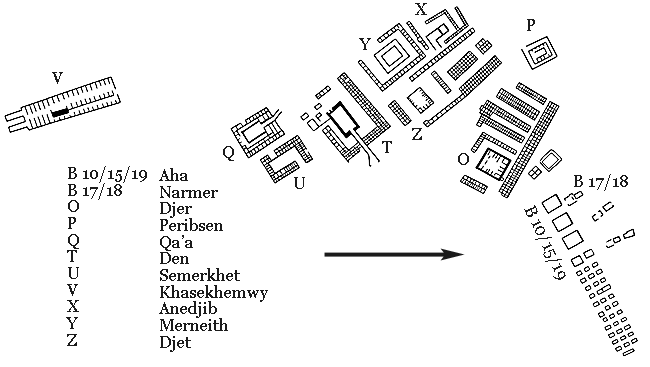
Plan of the Cemetery at Umm al-Qa'ab
The tombs belonging to the pharaohs of Dynasty I & II— along with that of Queen Merneith, who probably acted as regent for her son, Den—lie to the west and south of Cemetery B. Generally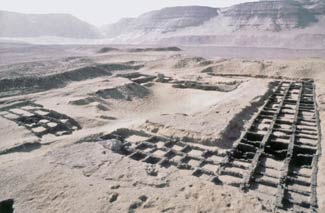 speaking, the burial chambers become larger more elaborate. They now included the store rooms as well as the wooden shrine where the body was laid out. From here on, the subsidiary graves consisted of rows of brick lined cells in trenches surrounding the principal tomb, such as at the Tomb of Den (right). Grave goods for the pharaoh’s servants included the usual pottery vessels but also the tools they would need to fulfil their roles in the afterlife. A number of stone stelae have been recovered from the rubble that name the individual buried and often give an indication of the service they performed for the pharaoh. They were uncarved on the back side, which suggests that they stood in niches but, other than that (and the fact that they must have been prominently displayed), nothing is known about their original locations. As the First Dynasty continued, there is a falling off in the number of
speaking, the burial chambers become larger more elaborate. They now included the store rooms as well as the wooden shrine where the body was laid out. From here on, the subsidiary graves consisted of rows of brick lined cells in trenches surrounding the principal tomb, such as at the Tomb of Den (right). Grave goods for the pharaoh’s servants included the usual pottery vessels but also the tools they would need to fulfil their roles in the afterlife. A number of stone stelae have been recovered from the rubble that name the individual buried and often give an indication of the service they performed for the pharaoh. They were uncarved on the back side, which suggests that they stood in niches but, other than that (and the fact that they must have been prominently displayed), nothing is known about their original locations. As the First Dynasty continued, there is a falling off in the number of 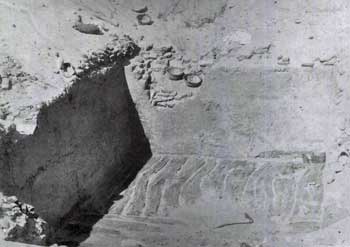 subsidiary burials and, by the end of the Second Dynasty the practice had come to an end.
subsidiary burials and, by the end of the Second Dynasty the practice had come to an end.
A large amount of wood, especially aromatic cedar, was used in furnishing the tomb. Wooden planks 5 cm thick were used to floor the burial chamber of Anedjib’s tomb (left) and traces were found in most of the others as well Wood was also used to panel the walls and to construct the various shrines set up around the coffin of the deceased. The burial chambers were roofed with wooden beams, reed mats and packed earth. Djer’s tomb (the largest) measures 12 x 13 metres, which is probably about the limit permitted by the building materials. In the case of the earlier tombs in the series, the roof was not put on until after the funeral. Den’s tomb, which was innovatory in so many ways, was the first to use dressed stone—the burial chamber had a floor of polished pink granite from Aswan.
The quantity and quality of the grave goods increased dramatically during this period— the evidence for that is clear, in spite of the repeated plundering of the cemetery. Most of the deposits were of pottery jars, filled with wine, oils, grain and other foodstuffs, some of which was imported 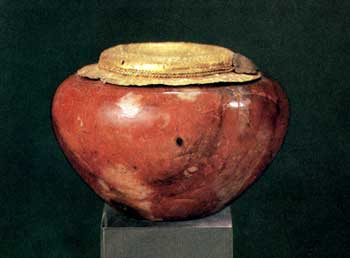 from Syria. In addition, there was a broad range of stone vessels, often laboriously carved out of the hardest of stones, such as the example (right) from Khasekhemwy’s tomb. In this particular instance the jar was meant to represent, in perpetuity, a clay vessel and its contents. It was even secured in the same manner, a cloth laid over the top and tied around the neck with string. In this case, however, there were gold copies of the originals. The choice of carnelian was appropriate—the Egyptians associated the stone with the warm blood of life.
from Syria. In addition, there was a broad range of stone vessels, often laboriously carved out of the hardest of stones, such as the example (right) from Khasekhemwy’s tomb. In this particular instance the jar was meant to represent, in perpetuity, a clay vessel and its contents. It was even secured in the same manner, a cloth laid over the top and tied around the neck with string. In this case, however, there were gold copies of the originals. The choice of carnelian was appropriate—the Egyptians associated the stone with the warm blood of life.
Copper tools, such as knives, axes, adzes and chisels have been found. In fact, many of them were an alloy of copper and arsenic, which was harder and kept its edge better than pure copper. True bronze, an alloy of copper and tin, has also been found in the shape of a pair of lustration vessels. Bits and pieces of broken furniture have also been recovered. Other offerings took place at the time of the funeral and occasionally evidence of them is found. Petrie records an overwhelming aroma of perfume when he excavated the tomb of Semerkhet. Sand to a depth of nearly a metre had been saturated with ointment had been dumped on the ramp leading to the burial chamber.
The tomb of Djet is the only royal tomb in which human remains have been found. A disembodied arm , wrapped with linen bandages, was discovered by Petrie at the beginning of the last century. The ownership of the arm is impossible to determine. Petrie thought it belonged to one of Den’s
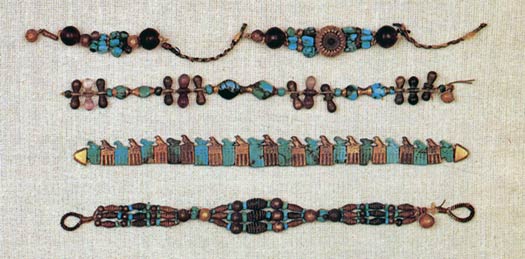
Jewellery from the Tomb of Den
minor wives but it is impossible to say for sure. The thieves had evidently chopped the body into bits to make it easier to remove and this particular bit was overlooked. The jewellery is of exceptional quality and shows that Egyptian craftsmen were masters of highly techniques such as filigree. The little bracelet of alternating serekhs made of gold, lapis lazuli and turquoise is particularly fine.
Den’s tomb is the first to use a stairway or ramp to gain access to the burial chamber, which meant that the tomb could now be finished and furnished while the king was still alive. This becomes 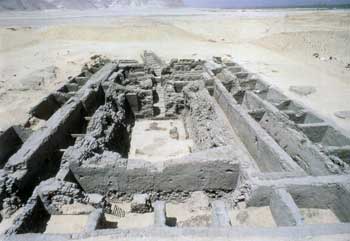 standard procedure for subsequent tombs. There was no particular orientation for these entrance passages—Den’s was on the northeast side while that of Qa’a (left) was on the northwest. Available space seems to have been the main consideration.
standard procedure for subsequent tombs. There was no particular orientation for these entrance passages—Den’s was on the northeast side while that of Qa’a (left) was on the northwest. Available space seems to have been the main consideration.
Royal tombs were apparently marked by a pair of stelae bearing the serekh of the pharaoh. Unfortunately, it is impossible to say for sure where they were set up since they have never been found in situ and were invariably broken. In most reconstructions, they are placed as a pair at one end of the superstructure. They vary widely in quality. None of the others come anywhere near the standard of Djet’s. They range in size from 1-2.5 metres high (with perhaps a quarter of it hidden below the surface).
For a long time it was generally assumed that each tomb was covered by a mound of sand and gravel held in place by a low mud brick walls. The material for the fill would have presumably come from the excavation of the burial pit. Petrie found evidence for retaining walls in his excavations but it now appears, thanks to the researches of Günter Dreyer, that these walls and the mound 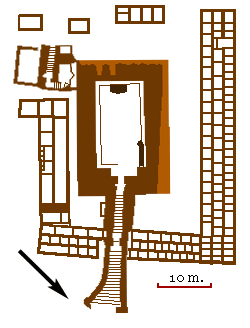 they enclosed were below ground level and would have been completely invisible. Thus, they were not intended to mark the grave but to fill some other function for the benefit of the deceased. An obvious one would have been as a stand-in for the mound of creation but, as mentioned above, there is no evidence to suggest that that concept was of any particular importance at this time.
they enclosed were below ground level and would have been completely invisible. Thus, they were not intended to mark the grave but to fill some other function for the benefit of the deceased. An obvious one would have been as a stand-in for the mound of creation but, as mentioned above, there is no evidence to suggest that that concept was of any particular importance at this time.
Another subterranean structure was discovered by the southern corner of the Tomb of Den (right). A staircase leads from the surface to a large room with a recess in the northwest wall. This is just the sort of structure that is known as a serdab to Egyptologists and was a common feature of Old Kingdom tombs. It was designed to hold the ka statue of the pharaoh. The ka was his spiritual double and also needed to be sustained with food and drink in the afterlife. Flanking the entrance to the top of the stairs is a pair of brick rectangular features that may have been where the stelae were set up. Nothing like this feature was found at any of the other tombs at Umm al-Qa’ab, but David O’Conner believes that similar structures may have stood at the surface by many if not all of them. There is a gap at the southwest corner of rows of subsidiary graves at all of the tombs that he believes was to give access to a such a chapel, all traces of which have since disappeared.
Umm al-Qa’ab was temporarily abandoned as a royal cemetery with the death of Qa’a and the end of Dynasty I. The first pharaohs of Dynasty II chose to be buried at Saqqara, which had been the capital of the two lands since the unification. Two suites of subterranean rock-cut galleries and chambers have been found to the south of Djoser’s step pyramid complex. These have been identified with Hotepsekhemwy (below) and Nynetjer. The super-structures have long since 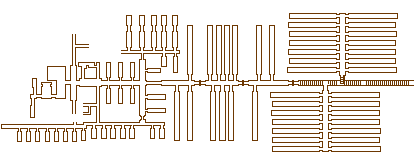 disappeared, removed to make way for the great monuments of the Old Kingdom. The capacity of these blocks of storage magazines was enormous. In the case of Hotepsekhemwy, it amounted to nearly 4,000 square metres—over five times the size of the largest Dynasty I tomb, that of Den, at Abydos. Virtually all of the extra space is for storage, a dramatic increase in the amount of wealth buried with the dead pharaoh. The superstructures of both tombs has entirely disappeared. Access to Hotepsekhemwy’s was by way of a long set of stairs and a series corridors which led to a suite of rooms at the rear of the tomb that included the burial chamber.
disappeared, removed to make way for the great monuments of the Old Kingdom. The capacity of these blocks of storage magazines was enormous. In the case of Hotepsekhemwy, it amounted to nearly 4,000 square metres—over five times the size of the largest Dynasty I tomb, that of Den, at Abydos. Virtually all of the extra space is for storage, a dramatic increase in the amount of wealth buried with the dead pharaoh. The superstructures of both tombs has entirely disappeared. Access to Hotepsekhemwy’s was by way of a long set of stairs and a series corridors which led to a suite of rooms at the rear of the tomb that included the burial chamber.
Peribsen and Khasekhemwy, the last two kings of the dynasty chose to return to Abydos to be buried. Political considerations are probably involved but we do not (and probably never will) fully understand the details. It has been suggested that Peribsen had lost control of Memphis but this was certainly not the case for Khasekhemwy. The tombs that they built for themselves were very

Tomb of Khasekhemwy
much influenced by developments at Saqqara, especially that of Khasekhemwy (above). There is the same banks of storerooms but in this case they envelope the burial chamber, which sits near the middle rather than at the end. The building was built in stages and buried well underground, 7 metres below the surface, in a huge trench— perhaps in imitation of the subterranean galleries at Saqqara. The storage capacity of Khasekhemwy’s tomb is far less than Hotepsekhemwy’s at Saqqara but there was more to the Abydos funerary monuments than just the tomb. About 1.5 km away to the north were a number of large mud brick structures belonging to the Early Dynastic rulers, their funerary enclosures.
Suggested Reading
Emery, W. B. |
1961 |
Archaic Egypt |
O'Connor, David |
2009 |
Abydos. Egypt's First Pharaohs & the Cult of Osiris |
Spencer, A. J. |
1993 |
Early Egypt. The Rise of Civilization in the Nile Valley |
Wilkinson, Toby A. H. |
1999 |
Early Dynastic Egypt |

